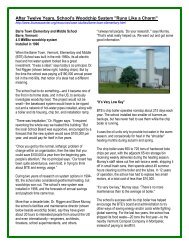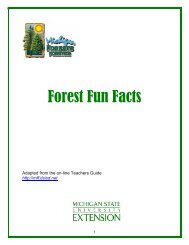Welcome and Introduction - Michigan Forests Forever - Delta ...
Welcome and Introduction - Michigan Forests Forever - Delta ...
Welcome and Introduction - Michigan Forests Forever - Delta ...
You also want an ePaper? Increase the reach of your titles
YUMPU automatically turns print PDFs into web optimized ePapers that Google loves.
MICHIGAN FORESTS FOREVER TEACHER’S GUIDE<strong>Welcome</strong>!This website was particularly designed for <strong>Michigan</strong> teachers.After the initial publication of the website [http://mff.dsisd.net], a number of teachersrequested PDF documents of the on-line material. While nearly all the web pages canbe printed directly from an Internet browser on only a few pages, the PDF documentscombine pages to better include similar topics. Of course, “hardcopy” files are updatedless often <strong>and</strong> cannot contain the dynamic page-linking of a website. The PDFdocuments are also formatted similarly so that all of the website content can bedownloaded for printing or digital storage. This revision of the MFF project was fundedby the <strong>Michigan</strong> Forest Foundation through a grant to MSU Extension.Not included in these PDF documents are the on-line Internet references, keyedpages to the <strong>Michigan</strong> education st<strong>and</strong>ards <strong>and</strong> benchmarks, <strong>and</strong> the linked activitysuggestions.The MFF project is an effort to provide information for teachers <strong>and</strong> classroomsabout forestry, especially concerning <strong>Michigan</strong>'s forests. There is a clear need toemphasize "forest management" material, simply because we could not find much "outthere" on the topic <strong>and</strong> because a number of teachers have requested this sort ofinformation. More importantly, <strong>Michigan</strong> has nationally outst<strong>and</strong>ing forests, a longhistory of forest management, <strong>and</strong> forests <strong>and</strong> forest industry is vital to our state (<strong>and</strong>not just in monetary terms).The USE <strong>and</strong> MANAGEMENT of <strong>Michigan</strong>'s forest is critical to the future well-beingof not only <strong>Michigan</strong> residents, but is integrated to the health <strong>and</strong> well-being of NorthAmerica <strong>and</strong> the rest of the world. Good forestry provides some of the finest examplesof "thinking globally <strong>and</strong> acting locally" that our State has to offer.We hope that the "<strong>Michigan</strong> <strong>Forests</strong> <strong>Forever</strong>" materials will be used state-wide in aneffort to heighten the awareness among school children about the vital connectionbetween people <strong>and</strong> forests. While it is true that "forests don't need people", it isequally true that "people need forests". Without thoughtful planning <strong>and</strong> management,the dem<strong>and</strong>s we place on our forests will overwhelm the forest's natural ability toprovide them.Finally, we hope the materials provide an easy-to-use, easy-to-underst<strong>and</strong>, <strong>and</strong>easy-to-implement resource for the classroom. Your suggestions are always welcome.1
Introductory Files <strong>and</strong> Five Topical Sections<strong>Introduction</strong>Forestry Fun FactsFAQs About ForestryBackground Essays (four of them)MFF GlossarySection One - Tree BasicsForest DescriptorsTree Identification<strong>Michigan</strong> Forest HistoryL<strong>and</strong> SurveyMap & CompassForest TrendsSection Two - Forest EnvironmentTree PhysiologyForest EcologyWildlife EcologyForest HealthNutrient <strong>and</strong> Water CyclesSection Three - Wood Products<strong>Michigan</strong> Forest IndustryGetting Wood to MarketSection Four - Forest RecreationForest Ownership & Recreation ActivitiesSection Five - BalanceA Forestry PrimerForest Management SystemsTree Planting2
Credits for the <strong>Michigan</strong> <strong>Forests</strong> <strong>Forever</strong> ProjectOne goal of this Teachers Guide is to provide as much material as possible free fromcopyright infringement issues. Nearly all the material is "fair game" for anyeducational effort. Only in a couple circumstances is acknowledgement needed formaterial. Also, a number of natural resource professionals <strong>and</strong> <strong>Michigan</strong> educatorshave reviewed the content of these pages for accuracy <strong>and</strong> balance. We thank them fortheir time <strong>and</strong> consideration in the development <strong>and</strong> improvement of this educationaltool.If portions of this website are used for educational materials, please cite "Bill Cook,<strong>Michigan</strong> State University Extension" as the source. If a full citation is requested fornon-commercial publications, please cite "Bill Cook, <strong>Michigan</strong> State UniversityExtension, Agriculture Hall, Room 108, <strong>Michigan</strong> State University, East Lansing, MI48824-1039". For commercial applications, please contact Bill Cook via email atcookwi@msu.edu.For bibliographic citation, the following is suggested. Cook, William. 2001. <strong>Michigan</strong><strong>Forests</strong> <strong>Forever</strong> Teacher's Guide Website. <strong>Michigan</strong> State University Extension,Agriculture Hall, East Lansing, <strong>Michigan</strong>, 48824-1039.Project Funding<strong>Michigan</strong> State University Extension<strong>Michigan</strong> Forest Resource Alliance<strong>Michigan</strong> Forest Foundation<strong>Michigan</strong> Forest AssociationWebsite Host <strong>and</strong> Server Maintenance<strong>Delta</strong>-Schoolcraft Intermediate School District2525 Third Avenue SouthEscanaba, MI 49829ImagesBeetle Life Cycle, image #0284015, ForestryImages.org, Painting by Richard Kliefoth,Photo by Ronald F. Billing.Asian Long-horned Beetle, American PestWhite Pine with Blister Rust, ForestryImages.org, Jana Albers, Minnesota DNR.Sudden Oak Death, Photo: P. Svihra, UCCE, Marin County, www.suddenoakdeath.orgAsian Ladybird Beetle, USDA Agricultural Research Service.Great Lakes Images, <strong>Michigan</strong> Sea Grant & <strong>Michigan</strong> State University, East Lansing,MI 48824-1222Historical logging photos in the Wood Products Section, Minnesota Historical Society(copyrights in effect).3
Charlotte Kindler, Escanaba SchoolsRon Kinnunen, <strong>Michigan</strong> Sea Grant & <strong>Michigan</strong> State University ExtensionFrank Laurence, Georgia-Pacific CorporationSherry Martine MacKinnon, <strong>Michigan</strong> DNR Wildlife Management DivisionGeorgia Peterson, <strong>Michigan</strong> State University ExtensionPrincipal AuthorBill Cook<strong>Michigan</strong> State University ExtensionUpper Peninsula Tree Improvement Center6005 J RoadEscanaba, MI 498295
References Used for the <strong>Michigan</strong> <strong>Forests</strong> <strong>Forever</strong> ProjectAmerican Forest Foundation. http://www.affoundation.orgBarnes, B.V. <strong>and</strong> W.H. Wagner. 2004. <strong>Michigan</strong> Trees. The University of <strong>Michigan</strong>Press. 448 pages.Botti, W.B. <strong>and</strong> M.D. Moore. 2006. <strong>Michigan</strong>'s State <strong>Forests</strong>: A Century ofStewardship. <strong>Michigan</strong> State University Press, Dave Dempsey Environmental StudySeries. 256 pages.Burt, William. 1981. Mammals of the Great Lakes Region. The University of <strong>Michigan</strong>Press. 246 pages.Center for Agricultural & Environmental Research & Training, Inc., www.caert.net,click on the “products” link, Environmental Resources Lesson Plan Library CD-ROM,Product No 3256Chase, Clarence D., R.E. Pfeifer, <strong>and</strong> J.S. Spencer, Jr. 1970. The Growing TimberResource of <strong>Michigan</strong> 1966. Resource Bulletin NC-9. St. Paul, MN: U.S. Departmentof Agriculture, Forest Service, North Central Forest Experiment Station. 62 pages.Daniels. Jess. 1995. "The Role of Applied Genetics in Silvicultural Systems". AWorkshop for Forest Resource Professionals <strong>and</strong> Administrators. 13-14 July, 1995.Cloquet Forestry Center. Cloquet, Minnesota.Dickmann, Donald. 2004. <strong>Michigan</strong> Forest Communities. <strong>Michigan</strong> State UniversityExtension Bulletin E-30000. 158 pp.Dickmann, Donald <strong>and</strong> L.A. Leefers. 2003. "The <strong>Forests</strong> of <strong>Michigan</strong>". TheUniversity of <strong>Michigan</strong> Press. 297 pages.Evers, D.C. 1992. A Guide to <strong>Michigan</strong>'s Endangered Wildlife. The University of<strong>Michigan</strong> Press. 104. pp.Forestry Tools. Supply companies include Forestry Suppliers <strong>and</strong> Ben Meadows.Gleason, H.A. <strong>and</strong> A. Cronquist. 1963. Manual of Vascular Plants of NortheasternUnited States <strong>and</strong> Adjacent Canada. D. Van Nostr<strong>and</strong> Company, New York, NewYork. 810 pages.Gleick, P.H. 1996. Water Resources. In Encyclopedia of Climate <strong>and</strong> Weather, ed. byS.H. Schneider. Oxford University Press, New York, vol. 2. pp. 817-823.6
GLFA (Great Lake Forestry Alliance). 1996. Tourism & Recreation; Lake StatesForest Facts. Great Lakes Forestry Alliance, Hayward, Wisconsin. 2 pages.Harding. J.H. <strong>and</strong> J.A. Holman. 1999. <strong>Michigan</strong> Frogs, Toads, <strong>and</strong> Salam<strong>and</strong>ers.<strong>Michigan</strong> State University Extension Bulletin E-2350. 144 pp.Harding. J.H. <strong>and</strong> J.A. Holman. 1997. <strong>Michigan</strong> Turtles <strong>and</strong> Lizards. <strong>Michigan</strong> StateUniversity Extension Bulletin E-2234. 94 ppHarlow, W.M. <strong>and</strong> E.S. Harrar. 1969. Textbook of Dendrology. McGraw-Hill BookCompany, New York, New York. 512 pages.Holman. J.A. <strong>and</strong> J.H. Harding. 2006. <strong>Michigan</strong> Snakes. <strong>Michigan</strong> State UniversityExtension Bulletin E-2000. 74 pp.Kershaw, L. 2006. Trees of <strong>Michigan</strong>. Lone Pine Publishing. 272 pages.Leatherberry, Earl C. <strong>and</strong> J.S. Spencer, Jr. 1993. <strong>Michigan</strong> Forest Statistics, 1993.Resource Bulletin NC-170. St. Paul, MN: U.S. Department of Agriculture, ForestService, North Central Forest Experiment Station. 144 pages.March<strong>and</strong>, Peter J. 1996. Life In The Cold. University Press of New Engl<strong>and</strong>,Hanover, New Hampshire. 304 pages.McDonough, Maureen, et al. 1999. The Role of Natural Resources in Community<strong>and</strong> Regional Economic Stability in the Eastern Upper Peninsula. Research Report568. Agricultural Experiment Station, <strong>Michigan</strong> State University, East Lansing,<strong>Michigan</strong>. 88 pages plus maps.<strong>Michigan</strong> DNR. 2000. "<strong>Michigan</strong> Forest Products Industry". Website URL:www.dnr.state.mi.us/wood/Miles, Patrick D., C.M. Chen, <strong>and</strong> E.C. Leatherberry. 1995. Minnesota ForestStatistics, 1990, Revised. Resource Bulletin NC-158. U.S. Department of Agriculture,Forest Service, North Central Forest Experiment Station, St. Paul, Minnesota. 138pages.MSU Extension <strong>and</strong> <strong>Michigan</strong> Sea Grant. 2000. Great Lakes Basin. Bulletin E-1865through E-1870. <strong>Michigan</strong> State University, East Lansing, <strong>Michigan</strong>. 6 maps withtables <strong>and</strong> text.MSU Extension. 1997. Identifying Trees of <strong>Michigan</strong>. Extension Bulletin E-2332.<strong>Michigan</strong> State University, East Lansing, <strong>Michigan</strong>. 23 pages.7
NASA Visible Earth Website (http://visibleearth.nasa.gov/). 2001. Image downloadsfor the "Great Lakes Page" in the Environment Section of the <strong>Michigan</strong> <strong>Forests</strong> <strong>Forever</strong>Teachers Guide.Nielsen. M.C. 1999. <strong>Michigan</strong> Butterflies & Skippers. <strong>Michigan</strong> State UniversityExtension Bulletin E-2675. 248 pp.Odum, Eugene. 1971. Fundamentals of Ecology. W.B. Saunders Company. 574pages.Owen, Oliver. 1971. Natural Resource Conservation, An Ecological Approach.MacMillan Company, New York, New York. 593 pages.Petrides, G.A. 1972. A Field Guide to Trees <strong>and</strong> Shrubs (Peterson Field GuideSeries). Houghton Mifflin Company, Boston, Massachusetts. 428 pages.Potter-Witter, Karen <strong>and</strong> J. Stevens. 1996. <strong>Michigan</strong> Forest Economy; The Facts.Publications <strong>and</strong> Design, Division of University Relations, <strong>Michigan</strong> State University.Pamphlet.Powell, Douglas S., J.L. Faulkner, D.R. Darr, Z. Zhu, <strong>and</strong> D.W. MacCleery. 1992.Forest Resources of the United States, 1992. General Technical Report RM-234. FortCollins, CO. U.S. Department of Agriculture, Forest Service, Rocky Mountain Forest<strong>and</strong> Range Experiment Station. 132 pages + map.Rehder, Alfred. 1940. Manual of Cultivated Trees <strong>and</strong> Shrubs Hardy in NorthAmerica. MacMillan Company, New York, New York. 996 pages.Schmidt, Thomas. 1996. Wisconsin Forest Statistics, 1996. Resource Bulletin NC-183. U.S. Department of Agriculture, Forest Service, North Central Forest ExperimentStation, St. Paul, Minnesota. 150 p.Schmidt-Nielsen, Knut. 1979. Animal Physiology. Cambridge University Press. 560pages.Smith, Brad W., J.L. Faulkner, <strong>and</strong> D.S. Powell. 1994. Forest Statistics of theUnited States, 1992. General Technical Report NC-168. St. Paul, MN: U.S.Department of Agriculture, Forest Service, North Central Forest Experiment Station.147 pages.Smith, Norman. 1997. Trees of <strong>Michigan</strong> <strong>and</strong> the Upper Great Lakes. Thunder BayPress. 178 pages.Society of American Foresters. Forestry Fact Sheets. Bethesda, Maryl<strong>and</strong>.www.safnet.org8
Tubbs, Carl H. 1977. Manager's H<strong>and</strong>book for Northern Hardwoods in the NorthCentral States. USDA Forest Service General Technical Report NC-39. North CentralForest Experiment Station, St. Paul, MN. 29 pages.U.S.D.A. Forest Service. 2000. U.S. Forest Facts <strong>and</strong> Historical Trends. Summaryfrom the 2000 Renewable Resources Planning Act Assessment. Downloadable PDFdocument from: http://fia.fs.fed.us/library/ForestFacts.pdf. 24 pages.Voss, Edward G. 1972. <strong>Michigan</strong> Flora, Part I Gymnosperms <strong>and</strong> Monocots.Cranbrook Institute of Science, Bloomfield Hills, <strong>Michigan</strong>. 488 pages.Voss, Edward G. 1985. <strong>Michigan</strong> Flora, Part II Dicots. Cranbrook Institute ofScience, Bloomfield Hills, <strong>Michigan</strong>. 727 pages.Voss, Edward G. 1996. <strong>Michigan</strong> Flora, Part III Dicots Concluded. Cranbrook Instituteof Science, Bloomfield Hills, <strong>Michigan</strong>. 488 pages.Whitaker, J.O. <strong>and</strong> W.J. Hamilton. 1998. Mammals of the Eastern United States.Cornell University Press. 583. pp.VIDEO TAPE SUGGESTIONS<strong>Michigan</strong> <strong>Forests</strong> <strong>Forever</strong>. 1998. <strong>Michigan</strong> Forest Resource Alliance. 23 minutes.The Right Choice.forestry.A Forest Vision.management.Two Sides of Fire.western oriented.Temperate Forest Foundation. 12 minutes. Choosing a career inTemperate Forest Foundation. Sustainability <strong>and</strong> the role of forestTemperate Forest Foundation. 15 minutes. The roles of fire,The Miracle Resource. Temperate Forest Foundation. 14 minutes. <strong>Forests</strong> <strong>and</strong>wood as a renewable choice.The Dynamic Forest.<strong>and</strong> dynamics.Temperate Forest Foundation. 15 minutes. Forest ecologyCircle of Life. Temperate Forest Foundation. 28 minutes. Production <strong>and</strong>consumption of natural resources.9
America's Forest; A History of Resiliency <strong>and</strong> Recovery. 1993. USDA ForestService <strong>and</strong> the Forest History Society. Temperate Forest Foundation. 23 minutes.U.S. forest history since European settlement.Materials <strong>and</strong> the Environment II. Temperate Forest Foundation. Global social,economic, <strong>and</strong> ecological consequences or raw material consumptive choices.Features Dr. Jim Bowyer, University of Minnesota.Managing Aspen in the Lake States (item 03746). Minnesota Extension Service. 27minutes.<strong>Forests</strong>: Providing Habitat For All. 1999. The <strong>Michigan</strong> Society of AmericanForesters. 14 minutes. How wood moves from the forest to a home built in cooperationwith Habitat for Humanity. Contact Bill Sterrett.Documents prepared by <strong>Michigan</strong> State University Extension.<strong>Michigan</strong> State University is an affirmative action equal opportunityemployer. The U.S. Department of Agriculture prohibits discriminationon the basis of race, color, national origin, gender, religion, age, disability,political beliefs, sexual orientation, <strong>and</strong> marital status or family status.(Not all prohibited bases apply to all programs.)10






